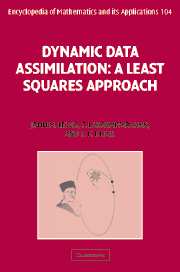Book contents
- Frontmatter
- Contents
- Preface
- Acknowledgements
- PART 1 GENESIS OF DATA ASSIMILATION
- PART II DATA ASSIMILATION: DETERMINISTIC/STATIC MODELS
- 5 Linear least squares estimation: method of normal equations
- 6 A geometric view: projection and invariance
- 7 Nonlinear least squares estimation
- 8 Recursive least squares estimation
- PART III COMPUTATIONAL TECHNIQUES
- PART IV STATISTICAL ESTIMATION
- PART V DATA ASSIMILATION: STOCHASTIC/STATIC MODELS
- PART VI DATA ASSIMILATION: DETERMINISTIC/DYNAMIC MODELS
- PART VII DATA ASSIMILATION: STOCHASTIC/DYNAMIC MODELS
- PART VIII PREDICTABILITY
- Epilogue
- References
- Index
5 - Linear least squares estimation: method of normal equations
from PART II - DATA ASSIMILATION: DETERMINISTIC/STATIC MODELS
Published online by Cambridge University Press: 18 December 2009
- Frontmatter
- Contents
- Preface
- Acknowledgements
- PART 1 GENESIS OF DATA ASSIMILATION
- PART II DATA ASSIMILATION: DETERMINISTIC/STATIC MODELS
- 5 Linear least squares estimation: method of normal equations
- 6 A geometric view: projection and invariance
- 7 Nonlinear least squares estimation
- 8 Recursive least squares estimation
- PART III COMPUTATIONAL TECHNIQUES
- PART IV STATISTICAL ESTIMATION
- PART V DATA ASSIMILATION: STOCHASTIC/STATIC MODELS
- PART VI DATA ASSIMILATION: DETERMINISTIC/DYNAMIC MODELS
- PART VII DATA ASSIMILATION: STOCHASTIC/DYNAMIC MODELS
- PART VIII PREDICTABILITY
- Epilogue
- References
- Index
Summary
In this chapter our goal is to describe the classical method of linear least squares estimation as a deterministic process wherein the estimation problem is recast as an optimization (minimization) problem. This approach is quite fundamental to data assimilation and was originally developed by Gauss in the nineteenth century (refer to Part I). The primary advantage of this approach is that it requires no knowledge of the properties of the observational errors which is an integral part of any measurement system. A statistical approach to the estimation, on the other hand, relies on a probabilistic model for the observational errors. One of the important facets of the statistical approach is that under appropriate choice of the probabilistic model for the observational errors, we can indeed reproduce the classical deterministic least squares solution described in this chapter. Statistical methods for estimation are reviewed in Part IV.
The opening Section 5.1 introduces the basic “trails of thought” leading to the first formulation of the linear least squares estimation using a very simple problem called the straight line problem (see Chapter 3 for details). This problem involves estimation of two parameters – the intercept and the slope of the straight line that is being “fitted” to a swarm of m points (that align themselves very nearly along a line) in a two-dimensional plane. An extension to the general case of linear models – m points in n dimensions (n ≧ 2) is pursued in Section 5.2. Thanks to the beauty and the power of the vector-matrix notation, the derivation of this extension is no more complex than the simple two-dimensional example discussed in Section 5.1.
Information
- Type
- Chapter
- Information
- Dynamic Data AssimilationA Least Squares Approach, pp. 99 - 120Publisher: Cambridge University PressPrint publication year: 2006
Accessibility standard: Unknown
Why this information is here
This section outlines the accessibility features of this content - including support for screen readers, full keyboard navigation and high-contrast display options. This may not be relevant for you.Accessibility Information
- 1
- Cited by
